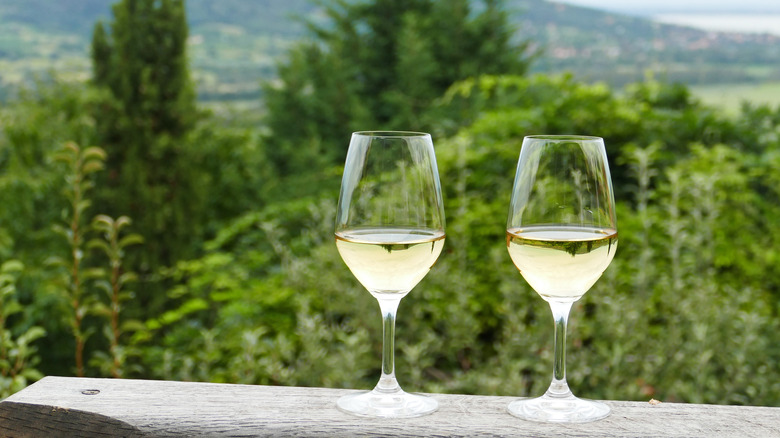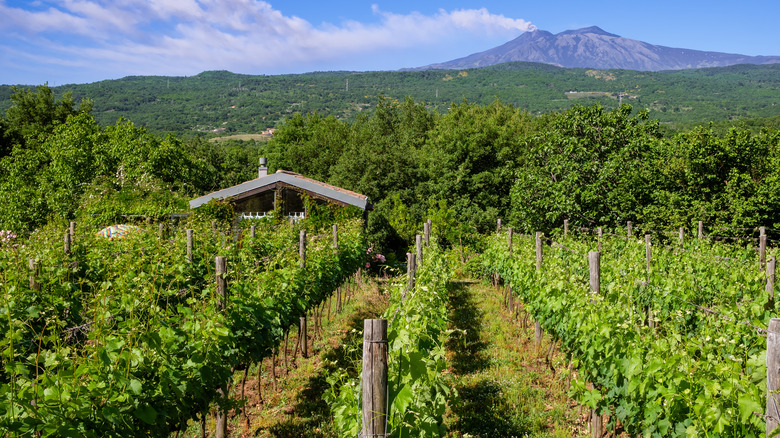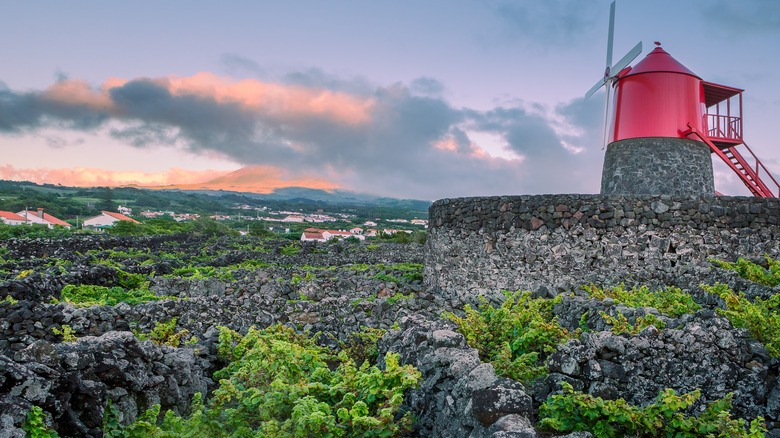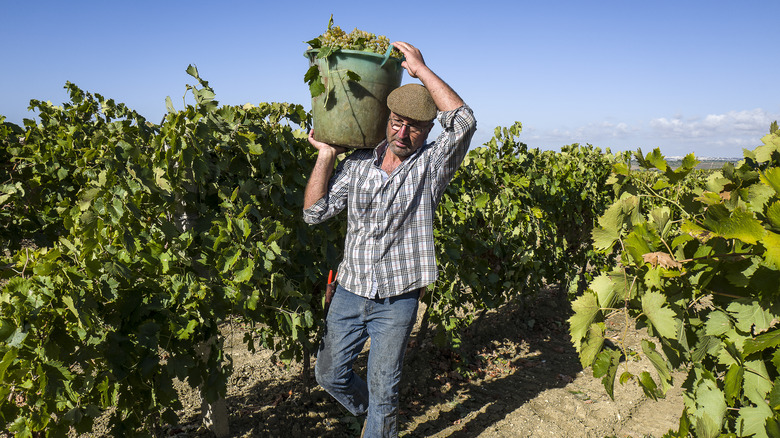Everything You Need To Know About Volcanic Wines
Like any crop, grapes that produce our favorite red or white wines are significantly impacted by their farming conditions. One of the most crucial elements to maturing a wine-centric grape is soil. Depending upon the soil quality and environment, the grape will directly be impacted based on its texture, depth, color, pH, and even drainage, according to the Sommeliers Choice Awards. Wine grapes grow with exceptional results in some of the most popular soil types: sandy, loam, limestone, silt, and volcanic.
Making up only 1% of the world's surface (via Bloomberg), it's surprising that volcanic soil makes up such a large percentage of the contributing soil for vineyards worldwide. Winemakers flock to volcanic soil for their grapes because of the superior quality of wine produced by the soil to create volcanic wine. Per Bloomberg, from the composition, quality of grapes, and overall taste, volcanic wine is considered one of the most superior gasses of vino in the world. Read on as we dive deep, uncovering what makes volcanic wine truly special.
What makes volcanic wine different?
Volcanic soils are typically infertile, unlike other soil types, as they don't hold or retain water (via Forbes). While this may deter the average farmer, vintners and winemakers believe there's a different type of beauty in growing wine grapes in volcanic soil. Per Forbes, The harsh conditions of vines grasping for water and nutrients through the rocky soil make the grapes smaller but the skins thicker. Delightfully, the environment and minerals cause the grapes to have thicker skins, giving the wine structure and rich flavor.
According to Food & Wine, volcanic rock and soil give the wine a distinctive character. While the moisture may be limiting, the mineral density in the soil is high, giving the wine a robust tautness and savory flavor profile. This enhancement to the grape (and the wine) draws winemakers in to build vineyards on volcanic soil — even when it can be more complex than traditional clay or sandy soil type.
Where can you find volcanic wine?
Thankfully, not all volcanic wines are found on the side of an erupting volcano. According to Food & Wine, volcanic wine can also be grown in previous volcanic sites that last erupted millions of years ago. You may be surprised to learn just how many volcanic vineyards there are worldwide.
In the United States, in Northern California, the Sonoma and Napa Valleys house many vineyards on volcanic sediment from current-day Sonoma Mountain (via Sonoma Mountain Preservation) and the Calistoga region (via Napa Valley Register), which has volcanic rocks that are four to nine million years old. Giving these regions' wines an excellent reputation, it's safe to say that the volcanic sediment is working in their favor.
In Europe, many vineyards are currently residing on current or previous volcanos with rich volcanic sedimentary rock. You'd likely find these wine country hubs scattered throughout islands and coastlines where volcanos are famously known to exist. Some of the best volcanic wines can be found in The Azores islands in Portugal, as well as in Sicily, Italy, and also along the coast of Santorini, Greece (via Bloomberg).
How is volcanic wine grown?
Like the name calls out, volcanic wines are grown near (or on) volcanos or volcanic remains. Because the soil is different, developing and making volcanic wine also differs slightly. Due to the soil's rich nutrients like iron (via Wine Enthusiast), the grapes grow with a more concentrated flavor. But due to lack of water excess, grapes will grow smaller. Many vineyards harvest by waiting for full-size grapes but volcanic vineyards will have smaller grapes when it's time to pick off the vine.
While a volcanic-soil-based vineyard may have less yield for its vintage, it isn't all sad. The combination of the grape's small water content and thick skins gives volcanic wine its famous taste that so many crave when asking for a glass of red or white wine. Year after year, vineyards in volcanic regions hope for this as it brings the flavor in the glass of wine to life.
How to spot a volcanic wine?
Whether you're a white or a red wine fan, there are volcanic wines for you to enjoy from all over the world. Luckily, many grapes are grown in volcanic soils so you can enjoy everything from a 100% Muscat grape blend from Italy to an orange wine from Portugal's Azores Islands (via Forbes).
When looking or shopping for a volcanic wine, these regions are essential to keep in mind. Traditionally, wine labels will focus on branding while listing the grape and region of the wine. It would be ideal to look for a descriptor that points out the region's qualities (like whether it was grown in volcanic soil). However, that isn't often the case. Instead, when shopping around your favorite wine store or ordering at a restaurant, ask your sommelier for their top volcanic wine picks with your choice of grape or style of wine. They will usually be more than happy to assist you.
We're excited for you to venture into the world of volcanic wine and experience the rich flavor with every sip.




